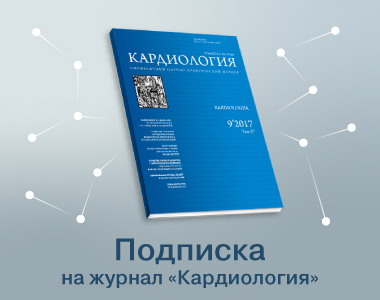Effectiveness of chronopharmacotherapy in salt-sensitive and salt-resistant patients with chronic heart failure and preserved ejection fraction
https://doi.org/10.18087/cardio.2479
Abstract
Keywords
About the Authors
V. V. SkibitskyRussian Federation
A. A. Kiselev
Russian Federation
A. V. Fendrikova
Russian Federation
References
1. Мареев В. Ю., Фомин И. В., Агеев Ф. Т., Арутюнов Г. П., Беграмбекова Ю. Л., Васюк Ю. А. и др. Хроническая СН (ХСН). Журнал Сердечная Недостаточность. 2017;18 (1):3-40. DOI:10.18087/rhfj. 2017.1.2346
2. Ponikowski P., Voors AA, Anker SD, Bueno H., ClelandJ GF, Coats AJS et al. 2016 ESC Guidelines for the diagnosis and treatment of acute and chronic heart failure: The Task Force for the diagnosis and treatment of acute and chronic heart failure of the European Society of Cardiology (ESC) Developed with the special contribution of the Heart Failure Association (HFA) of the ESC. European Heart Journal. 2016;37 (27):2129-200. DOI:10.1093/eurheartj/ehw128
3. Фомин И. В., Беленков Ю. Н., Мареев В. Ю., Агеев Ф. Т., Бадин Ю. В., Галявич А. С. и др. Распространенность ХСН в Европейской части Российской Федерации - данные ЭПОХА - ХСН (Часть II). Журнал Сердечная Недостаточность. 2006;7 (3):112-5.
4. Фомин И. В. Хроническая СН в Российской Федерации: что сегодня мы знаем и что должны делать. Российский кардиологический журнал. 2016; (8):7-13. DOI:10.15829/1560-4071-2016-8-7-13
5. Marwick TH, Ritchie R., ShawJE, Kaye D. Implications of Underlying Mechanisms for the Recognition and Management of Diabetic Cardiomyopathy. Journal of the American College of Cardiology. 2018;71 (3):339-51. DOI:10.1016/j. jacc. 2017.11.019
6. Арутюнов Г. П., Драгунов Д. О., Арутюнов А. Г., Соколова А. В., Кильдюшов Е. М., Негребецкий В. В. и др. Влияние уровня общего натрия, депонированного в миокарде, на его жесткость. Терапевтический архив. 2017;89 (1):32-7.
7. Zinman B., Wanner C., LachinJM, Fitchett D., Bluhmki E., Hantel S. et al. Empagliflozin, Cardiovascular Outcomes, and Mortality in Type 2 Diabetes. New England Journal of Medicine. 2015;373 (22):2117-28. DOI:10.1056/NEJMoa1504720
8. Кобалава Ж. Д., Виллевальде С. В., Троицкая Е. А. Потребление поваренной соли и АГ: есть ли основания для смены позиций? Кардиология. 2013;53 (11):75-83.
9. Rust P., Ekmekcioglu C. Impact of Salt Intake on the Pathogenesis and Treatment of Hypertension. Adv Exp Med Biol. 2017;956:61-84. DOI:10.1007/5584_2016_147
10. Yamamoto M., Ishizu T., Seo Y., Suto Y., Sai S., Xu D. et al. Teneligliptin Prevents Cardiomyocyte Hypertrophy, Fibrosis, and Development of Hypertensive Heart Failure in Dahl Salt-Sensitive Rats. Journal of Cardiac Failure. 2018;24 (1):53-60. DOI:10.1016/j. cardfail. 2017.09.001
11. Yim J., Cho H., Rabkin S.W. Gene expression and gene associations during the development of heart failure with preserved ejection fraction in the Dahl salt sensitive model of hypertension. Clinical and Experimental Hypertension. 2018;40 (2):155-66. DOI:10.1080/1064196 3.2017.1346113
12. Hermida RC, Ayala DE, Fernandez JR, Mojon A., Smolensky MH, Fabbian F. et al. Administration-Time Differences in Effects of Hypertension Medications on Ambulatory Blood Pressure Regulation. Chronobiology International. 2013;30 (1-2):280-314. DOI:10.310 9 / 074205 28.2012.709448
13. Харченко В. И., Люсов В. А., Рифаи М. А. Солевые, водные нагрузки и водно-натриевый обмен у больных гипертонической болезнью. Терапевтический архив. 1984;56 (12):48-55.
14. Nagueh SF, Smiseth OA, Appleton CP, Byrd BF, Dokainish H., Edvardsen T. et al. Recommendations for the evaluation of left ventricular diastolic function by echocardiography: an update from the American Society of Echocardiography and the European Association of Cardiovascular Imaging. J. Am Soc Echocardiogr. 2016;29 (4):277-314. DOI:10.1016/j. echo. 2016.01.011
15. Dominguez-Vias G., Aretxaga-Maza G., Prieto I., LunaJ de D., De Gasparo M., Ramirez-Sanchez M. Diurnal opposite variation between angiotensinase activities in photo - neuro - endocrine tissues of rats. Chronobiology International. 2017;34 (9):1180-6. DOI:10.1080/07420 528.2017.1354871
16. Ohashi N., Isobe S., Ishigaki S., Yasuda H. Circadian rhythm of blood pressure and the renin - angiotensin system in the kidney. Hypertension Research. 2017;40 (5):413-22. DOI:10.1038/hr. 2016.166
17. Скибицкий В. В., Киселев А. А., Фендрикова А. В. Эффективность комбинированной антигипертензивной терапии с учетом солечувствительностипациентов с неконтролируемой АГ и СД 2 типа. Проблемы Женского Здоровья. 2016;11 (4):15-24.
18. Hermida RC, Ayala DE, Mojon A., Fernandez J.R. Sleep-Time Ambulatory BP Is an Independent Prognostic Marker of CKD. Journal of the American Society of Nephrology. 2017;28 (9):2802-11. DOI:10.1681/ASN. 2016111186
19. Isobe-Sasaki Y., Fukuda M., Ogiyama Y., Sato R., Miura T., Fuwa D. et al. Sodium balance, circadian BP rhythm, heart rate variability, and intrarenal renin-angiotensin-aldosterone and dopaminergic systems in acute phase of ARB therapy. Physiological Reports. 2017;5 (11):e13309. DOI: 10.14814/phy2.13309
20. Culver S., Li C., Siragy H.M. Intrarenal Angiotensin-Converting Enzyme: the Old and the New. Current Hypertension Reports [Интернет]. 2017 [цитируется по 10 июнь 2018 г.];19 (10). DOI:10.1007/s11906-017-0778-2
21. Pavlov TS, Levchenko V., Ilatovskaya DV, Moreno C., Staruschenko A. Renal sodium transport in renin-deficient Dahl salt-sensitive rats. Journal of the Renin-Angiotensin-Aldosterone System [Интернет]. 2016 [цитируется по 10 июнь 2018 г.];17 (3). DOI:10.1177/1470320316653858
22. Garg R., Sun B., Williams J. Effect of Low Salt Diet on Insulin Resistance in Salt-Sensitive Versus Salt-Resistant Hypertension Novelty and Significance. Hypertension. 2014;64 (6):1384-7. DOI:10.1161/HY-PERTENSIONAHA. 114.03880
23. Bitarova ZV, Remizov OV, Astakhovа Z.T. Effect ofACE inhibitor and receptor antagonist of type 1 angiotensin II on hemodynamics and morpho-functional parameters of the heart in patients with heart failure on a background of coronary heart disease combined with type 2 diabetes. Kubanskij nauchnyj medicinskij vestnik. 2017;24 (3):11-6. DOI:10.25207/1608-6228-2017-24-3-11-16
24. Chen P., Chaugai S., Zhao F., Wang D.W. Cardioprotective Effect of Thiazide-Like Diuretics: A Meta-Analysis. AmericanJournal of Hypertension. 2015;28 (12):1453-63. DOI:10.1093/ajh/hpv050
25. Pareek AK, Mehta RT, Purkait I., Grover A. Diabetic Hypertensives and Diastolic Dysfunction. JACC: Heart Failure. 2017;5(11):850-1. DOI:10.1016/j.jchf.2017.08.003
Review
For citations:
Skibitsky V.V., Kiselev A.A., Fendrikova A.V. Effectiveness of chronopharmacotherapy in salt-sensitive and salt-resistant patients with chronic heart failure and preserved ejection fraction. Kardiologiia. 2018;58(8S):12-19. (In Russ.) https://doi.org/10.18087/cardio.2479















